Effect of Hole Shift on Threshold Characteristics of GaSb-Based Double-Hole Photonic-Crystal Surface-Emitting Lasers
Abstract
:1. Introduction
2. Materials and Methods
3. Results and Discussions
4. Conclusions
Supplementary Materials
Author Contributions
Funding
Institutional Review Board Statement
Informed Consent Statement
Data Availability Statement
Acknowledgments
Conflicts of Interest
References
- Hirose, K.; Liang, Y.; Kurosaka, Y.; Watanabe, A.; Sugiyama, T.; Noda, S. Watt-Class High-Power, High-Beam-Quality Photonic-Crystal Lasers. Nat. Photon. 2014, 8, 406–411. [Google Scholar] [CrossRef]
- Yoshida, M.; De Zoysa, M.; Ishizaki, K.; Tanaka, Y.; Kawasaki, M.; Hatsuda, R.; Song, B.; Gelleta, J.; Noda, S. Double-Lattice Photonic-Crystal Resonators Enabling High-Brightness Semiconductor Lasers with Symmetric Narrow-Divergence Beams. Nat. Mater. 2019, 18, 121–128. [Google Scholar] [CrossRef] [PubMed]
- Sakata, R.; Ishizaki, K.; De Zoysa, M.; Fukuhara, S.; Inoue, T.; Tanaka, Y.; Iwata, K.; Hatsuda, R.; Yoshida, M.; Gelleta, J.; et al. Dually Modulated Photonic Crystals Enabling High-Power High-Beam-Quality Two-Dimensional Beam Scanning Lasers. Nat. Commun. 2020, 11, 3487. [Google Scholar] [CrossRef] [PubMed]
- Yu, P.; Fang, D.; Tang, J.; Fang, X.; Wang, D.; Wang, X.; Wang, X.; Wei, Z. Research Progress of 2–5 µm Mid-Infrared GaSb Semiconductor Materials. Appl. Phys. 2018, 8, 45–61. [Google Scholar] [CrossRef]
- Sifferman, S.D.; Nair, H.P.; Salas, R.; Sheehan, N.T.; Maddox, S.J.; Crook, A.M.; Bank, S.R. Highly Strained Mid-Infrared Type-I Diode Lasers on GaSb. IEEE J. Sel. Top. Quantum Electron. 2015, 21, 1502410. [Google Scholar] [CrossRef]
- Pan, C.H.; Lin, C.H.; Chang, T.Y.; Lu, T.C.; Lee, C.P. GaSb-Based Mid Infrared Photonic Crystal Surface Emitting Lasers. Opt. Express 2015, 23, 11741–11747. [Google Scholar] [CrossRef] [PubMed]
- Li, Z.L.; Chang, B.H.; Lin, C.H.; Lee, C.P. Dual-Wavelength GaSb-Based Mid Infrared Photonic crystal Surface Emitting Lasers. J. Appl. Phys. 2018, 123, 093102. [Google Scholar] [CrossRef]
- Cheng, H.W.; Lin, S.C.; Li, Z.L.; Sun, K.W.; Lee, C.P. PCSEL Performance of Type-I InGaAsSb Double-QWs Laser Structure Prepared by MBE. Materials 2019, 12, 317. [Google Scholar] [CrossRef] [PubMed] [Green Version]
- Li, Z.L.; Lin, S.C.; Lin, G.; Cheng, H.W.; Sun, K.W.; Lee, C.P. Effect of Etching Depth on Threshold Characteristics of GaSb-Based Middle Infrared Photonic-Crystal Surface-Emitting Lasers. Micromachines 2019, 10, 188. [Google Scholar] [CrossRef] [PubMed] [Green Version]
- Liang, Y.; Peng, C.; Sakai, K.; Iwahashi, S.; Noda, S. Three-Dimensional Coupled-Wave Model for Square-Lattice Photonic Crystal Lasers with Transverse Electric Polarization: A General Approach. Phys. Rev. B 2011, 84, 195119. [Google Scholar] [CrossRef] [Green Version]
- Liang, Y.; Peng, C.; Sakai, K.; Iwahashi, S.; Noda, S. Three-Dimensional Coupled-Wave Analysis for Square-Lattice Photonic Crystal Surface Emitting Lasers with Transverse-Electric Polarization: Finite-Size Effects. Opt. Express 2012, 20, 15945–15961. [Google Scholar] [CrossRef] [PubMed]
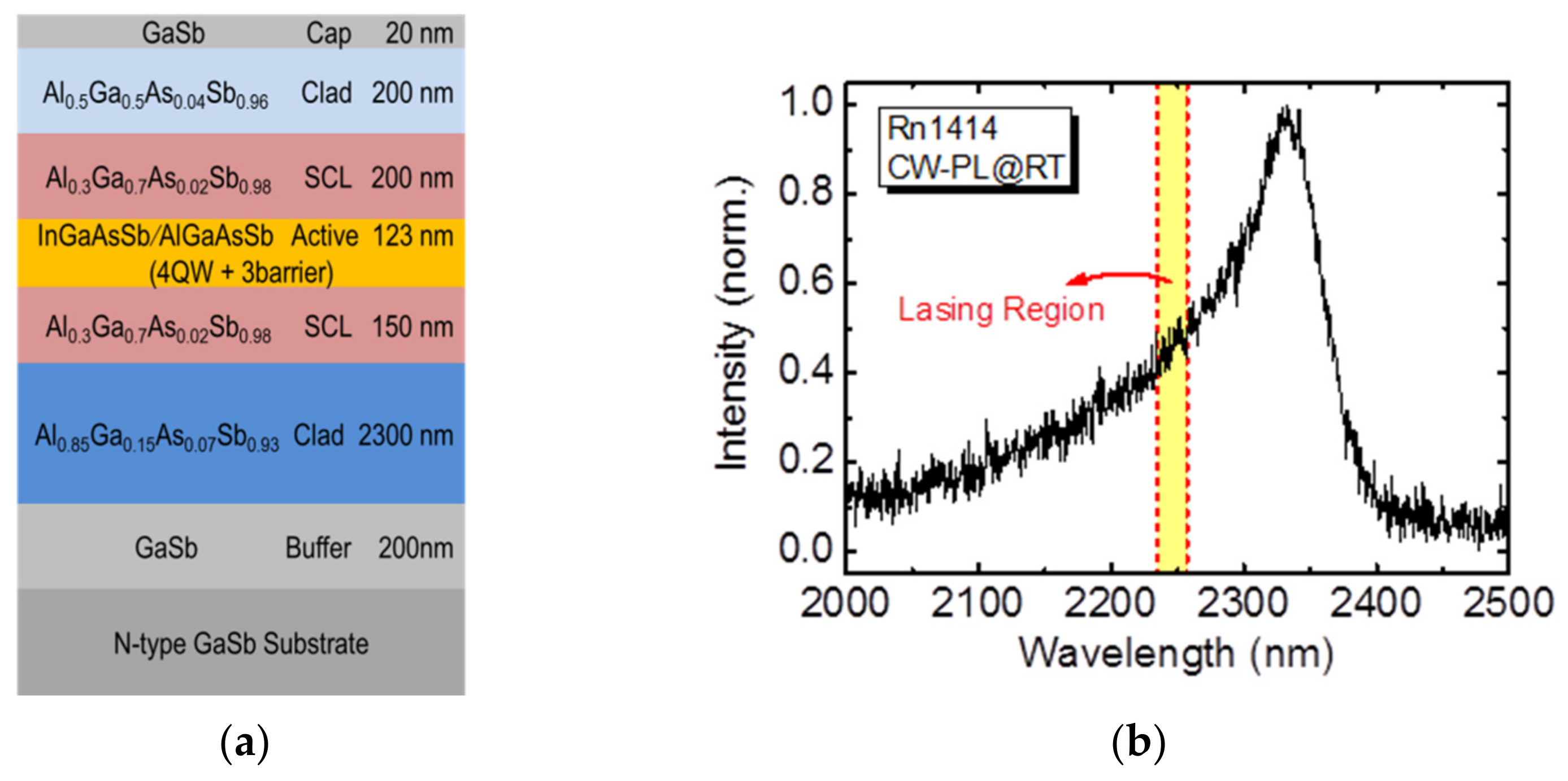

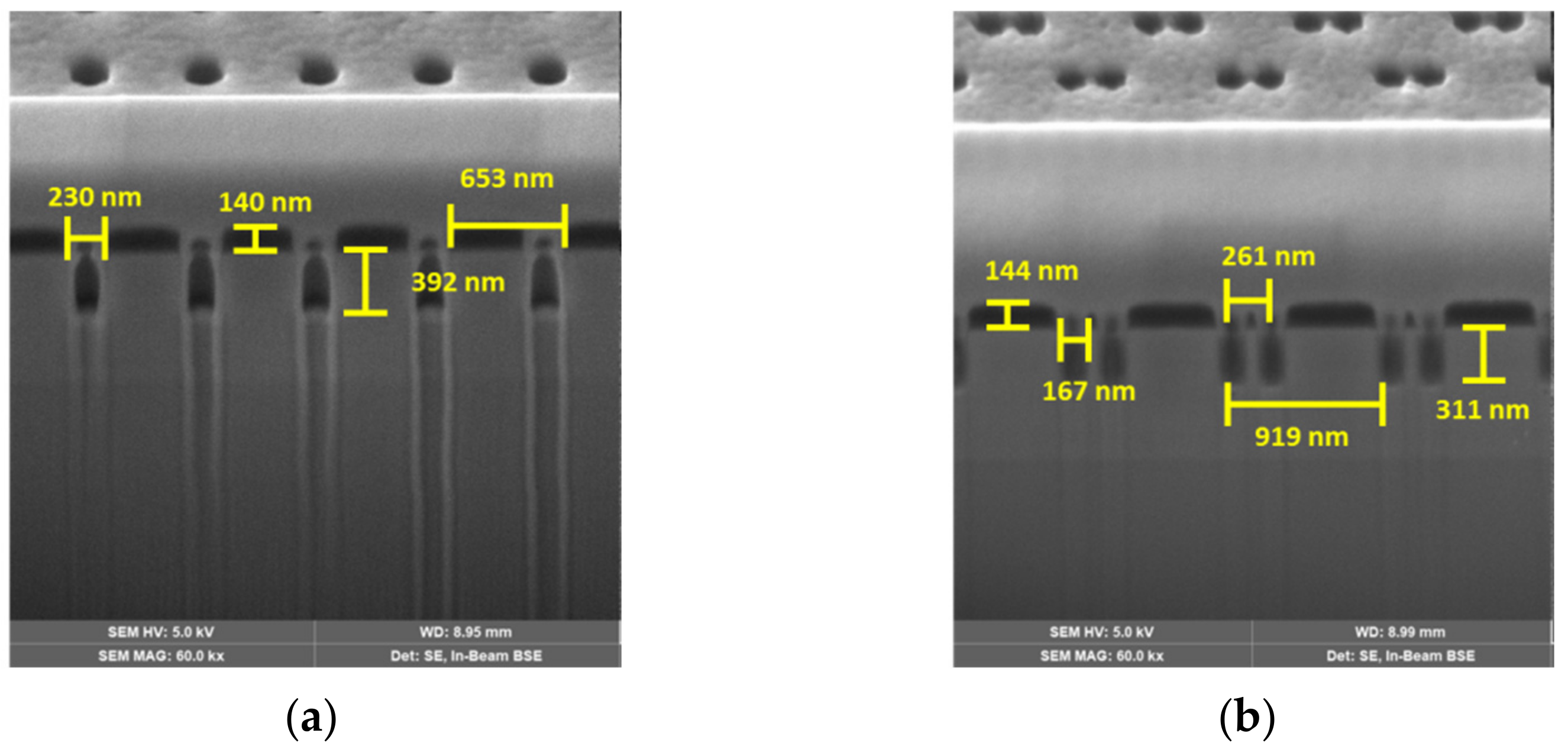
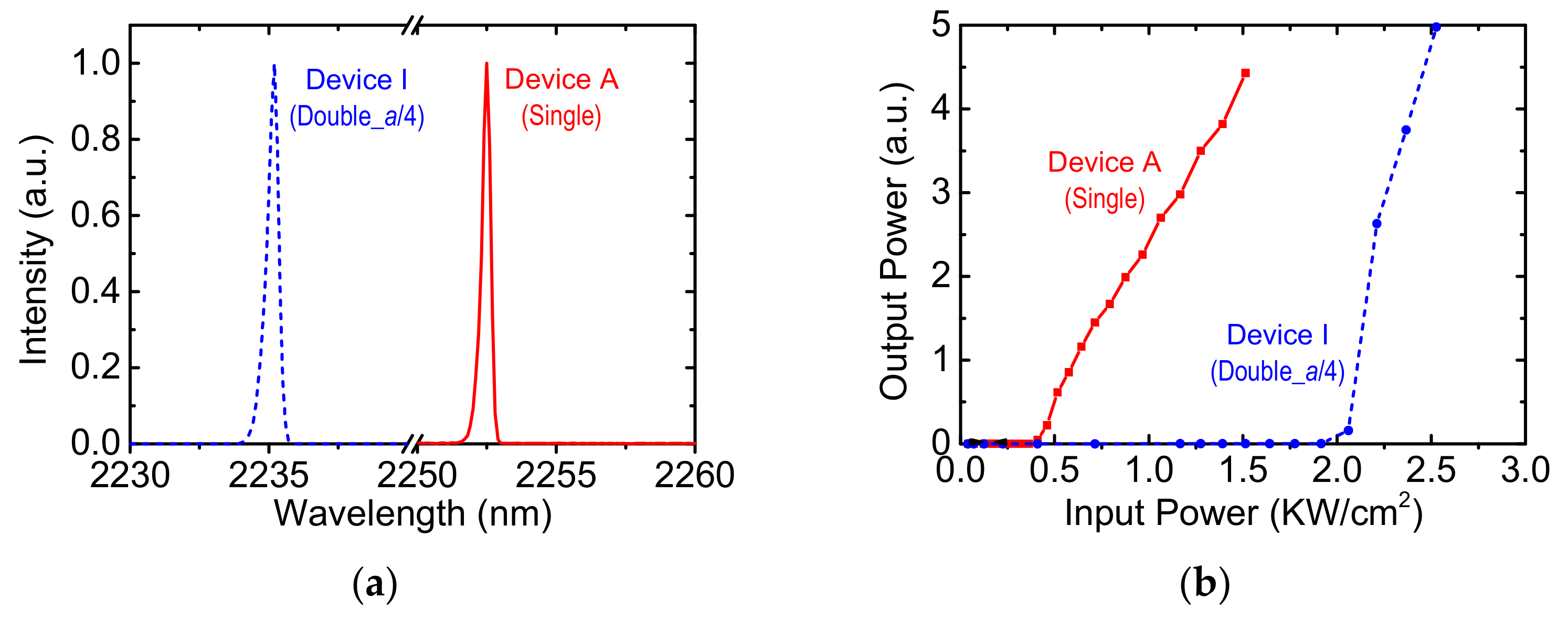
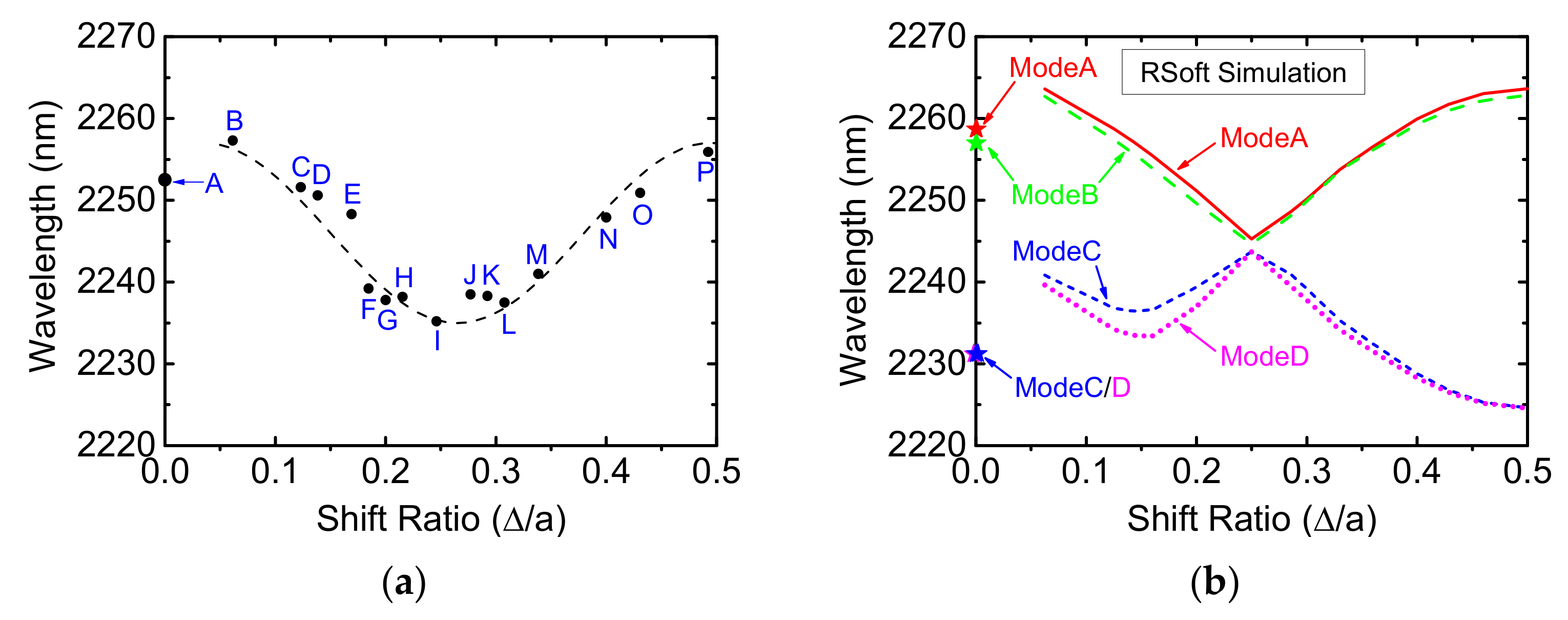
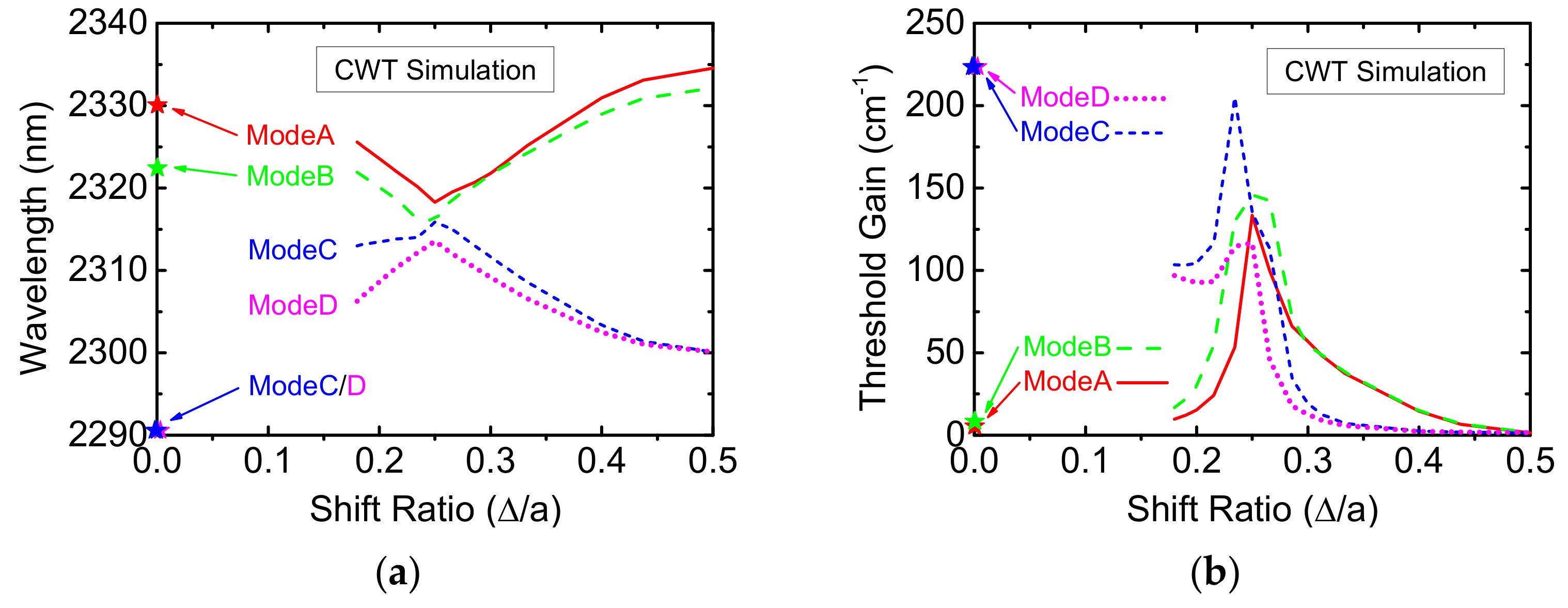

| Device No. | Designed Δ (nm) | Measured r1/r2 (nm) | Measured FF (%) |
|---|---|---|---|
| A | 0 | 104.8 | 8.4 |
| B | 40 | 81.8 | 6.8 |
| C | 80 | 80.3 | 8.8 |
| D | 90 | 79.6 | 8.3 |
| E | 110 | 81.9 | 9.2 |
| F | 120 | 81.8 | 9.7 |
| G | 130 | 81.0 | 9.7 |
| H | 140 | 83.3 | 10.9 |
| I | 160 | 79.9 | 9.7 |
| J | 180 | 77.9 | 9.4 |
| K | 190 | 77.6 | 9.5 |
| L | 200 | 80.9 | 10.2 |
| M | 220 | 80.6 | 10.0 |
| N | 260 | 76.9 | 9.1 |
| O | 280 | 78.5 | 9.6 |
| P | 320 | 83.0 | 10.5 |
Publisher’s Note: MDPI stays neutral with regard to jurisdictional claims in published maps and institutional affiliations. |
© 2021 by the authors. Licensee MDPI, Basel, Switzerland. This article is an open access article distributed under the terms and conditions of the Creative Commons Attribution (CC BY) license (https://creativecommons.org/licenses/by/4.0/).
Share and Cite
Huang, Y.-H.; Yang, Z.-X.; Cheng, S.-L.; Lin, C.-H.; Lin, G.; Sun, K.-W.; Lee, C.-P. Effect of Hole Shift on Threshold Characteristics of GaSb-Based Double-Hole Photonic-Crystal Surface-Emitting Lasers. Micromachines 2021, 12, 468. https://doi.org/10.3390/mi12050468
Huang Y-H, Yang Z-X, Cheng S-L, Lin C-H, Lin G, Sun K-W, Lee C-P. Effect of Hole Shift on Threshold Characteristics of GaSb-Based Double-Hole Photonic-Crystal Surface-Emitting Lasers. Micromachines. 2021; 12(5):468. https://doi.org/10.3390/mi12050468
Chicago/Turabian StyleHuang, Yu-Hsun, Zi-Xian Yang, Su-Ling Cheng, Chien-Hung Lin, Gray Lin, Kien-Wen Sun, and Chien-Ping Lee. 2021. "Effect of Hole Shift on Threshold Characteristics of GaSb-Based Double-Hole Photonic-Crystal Surface-Emitting Lasers" Micromachines 12, no. 5: 468. https://doi.org/10.3390/mi12050468
APA StyleHuang, Y.-H., Yang, Z.-X., Cheng, S.-L., Lin, C.-H., Lin, G., Sun, K.-W., & Lee, C.-P. (2021). Effect of Hole Shift on Threshold Characteristics of GaSb-Based Double-Hole Photonic-Crystal Surface-Emitting Lasers. Micromachines, 12(5), 468. https://doi.org/10.3390/mi12050468







